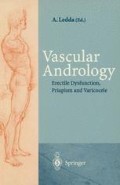Abstract
Intracavernosal pharmacotherapy became popular between 1982 and 1983 when Virag [14] and Brindley [3] demonstrated that injection of papaverine, phentolamine, and phenoxybenzamine into the cavernosal body induces a penile erection. One year later Virag [15] proposed a therapeutic protocol based on “self-injection”. Patients suffering from penile erectile deficiency were examined, and those who showed a favorable response to intracavernous injections of papaverine were taught a technique that provides a “self-erection”. Zorgniotti and Lefleur [17] in 1985 proposed a combination of papaverine and phentolamine, and immediately thereafter the use of prostaglandin E1 (PGE1) became a common practice. This drug was preferred over the others because of its lower rate of side effects, prolonged erections, and priapism than that with papaverine or papaverine + phentolamine. Today the use of these drugs has become routine, and constitutes either singularly or in combination the first step of every therapeutic protocol that deals with erectile dysfunction.
Access this chapter
Tax calculation will be finalised at checkout
Purchases are for personal use only
Preview
Unable to display preview. Download preview PDF.
References
Abozeid M, Juenemann KP, Luo J, et al (1987) Chronic papaverine treatment: the effect of repeated injections on the simian erectile response and penile tissue. J Urol 138:1263–1266
Belcaro G, Fisher C, Veller M et al (1993) Screening asymptomatic subjects with subclinical arteriosclerotic lesions with arterial ultrasonic biopsy. The PAP study. VASA 22/23:232–240
Brindley GS (1983) Cavernosal alpha-blockade: a new technique for investigating and treating erectile impotence. Br J Psychiatry 143:332
Conti G, Virag R (1989) Human penile erection and organic impotence. Normal hystology and hystopathology. In: Mayor G (ed) Urologia internationalis, vol 44. Karger, Basel, pp 303–308
Ledda A, Seccia M, Martegiani C, Tenaglia R (1988) 18 mesi di esperienze con le farmacoprotesi peniene. Presented at the 61st Congress of the SIU, Cagliari, 20–23 September
Levine S, Althof SE, Turner LA, Risen CB et al (1989) Side effects of self-administration of intracavernous papaverine and phentolamine fore the treatment of impotence. J Urol 141:54
Lue TF, Tanagho EA (1987) Physiology of erection and pharmacological management of impotence. J Urol 137:829
Michal V, Kramar R, Pospichal J, Hejhol L (1977) Arterial epigastricocavernous anastomosis for the treatment of sexual impotence. World J Surg 1:515
Porst H (1994) Ten years of experience with various vasoactive drugs. Comparative studies in over 4000 patients. Int J Impotence Res 6[Suppl 1]:D149
Saenz de Tejada I, Goldstein I, Azadzoi K, Krane RJ et al (1998) Impaired neur-ogenic and endothelium-mediated relaxation of arterial smooth muscle from diabetic men with impotence. N Engl J Med 320:1025
Sidi A, Cameron J, Duffy L, ND Lange P (1986) Intracavernous drug-induced erections in the management of male erectile dysfunction: experience with 100 patients. J Urol 135:704
Sidi A, Reddy P, Chen K (1988) Patient acceptance of and satisfaction with vasoactive intracavernous pharmacotherapy for impotence. J Urol 140:293
Stackl W, Hasun R, Merberger M (1988) Intracavernous injection of prostaglandin E1 in impotent men. J Urol 140:66–68
Virag (1982) Intracavernous injection of papaverine for erectile failure. Letter to the Editor. Lancet 2:938
Virag (1984) Intracavernous injection of papaverine as a diagnostic and therapeutic method in erectile failure. Angiology 35:79/87
Virag R, Adaikan PG (1987) Effects of prostaglandin E1 on penile erection and erectile failure. J Urol 139:1010
Zorgniotti AW, Lefleur RS (1988) Auto-injection of the corpus cavernosum with a vasoactive drug combination for vasculogenic impotence. J Urol 133:39–41
Editor information
Editors and Affiliations
Rights and permissions
Copyright information
© 1996 Springer -Verlag Berlin Heidelberg
About this chapter
Cite this chapter
Ledda, A. (1996). Intracavernosal Drug Therapy. In: Ledda, A. (eds) Vascular Andrology. Springer, Berlin, Heidelberg. https://doi.org/10.1007/978-3-642-79853-5_7
Download citation
DOI: https://doi.org/10.1007/978-3-642-79853-5_7
Publisher Name: Springer, Berlin, Heidelberg
Print ISBN: 978-3-540-59472-7
Online ISBN: 978-3-642-79853-5
eBook Packages: Springer Book Archive

